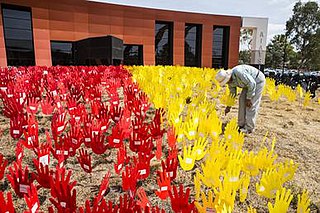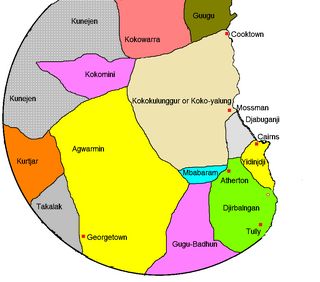Related Research Articles
Guugu Yimithirr, also rendered Guugu Yimidhirr, Guguyimidjir, and many other spellings, is an Australian Aboriginal language, the traditional language of the Guugu Yimithirr people of Far North Queensland. It belongs to the Pama-Nyungan language family. Most of the speakers today live at the community of Hope Vale, about 46 kilometres (29 mi) from Cooktown. However, as of June 2020 only about half of the Guugu Yimithirr nation speak the language. As such, efforts are being made to teach it to children. Guugu Yimithirr is the source language of the word kangaroo.

The Australian Institute of Aboriginal and Torres Strait Islander Studies (AIATSIS), established as the Australian Institute of Aboriginal Studies (AIAS) in 1964, is an independent Australian Government statutory authority. It is a collecting, publishing, and research institute and is considered to be Australia's premier resource for information about the cultures and societies of Aboriginal and Torres Strait Islander peoples.

Woiwurrung and Taungurung are Aboriginal languages of the Kulin nation of Central Victoria. Woiwurrung was spoken by the Woiwurrung and related peoples in the Yarra River basin, and Taungurung by the Taungurung people north of the Great Dividing Range in the Goulburn River Valley around Mansfield, Benalla and Heathcote. They are often portrayed as distinct languages, but they were mutually intelligible. Ngurai-illamwurrung (Ngurraiillam) may have been a clan name, a dialect, or a closely related language.
Darkinjung is an Australian Aboriginal language, the traditional language of the Darkinjung people. While no audio recordings of the language survive, several researchers have compiled wordlists and grammatical descriptions. It has been classified as a language no longer fully spoken and it can be classified as needing a language renewal program. It was spoken adjacent to Dharuk, Wiradhuri, Guringai, Gamilaraay, and Awabakal. The Darkinjung tribe occupied a small part of southeastern Australia inside what is now the New South Wales area. They likely inhabited a considerable tract of land within Hunter, Northumberland, and Cook counties.
Ngardi, also spelt Ngarti or Ngardilj, is an Australian Aboriginal language that is considered moribund. It was previously thought to be an alternative name for the Bunara language, but these are now classified as separate languages. It was/is spoken by the Ngarti people of the Northern Territory and northern Western Australia.

The Gunaikurnai or Gunai/Kurnai language, also spelt Gunnai, Kurnai, Ganai, Gaanay, or Kurnay KUR-nye) is an Australian Aboriginal dialect cluster of the Gunaikurnai people in Gippsland in south-east Victoria. Bidawal was either a divergent dialect or a closely related language.

The Paman languages are an Australian language family spoken on Cape York Peninsula, Queensland. First noted by Kenneth Hale, Paman is noteworthy for the profound phonological changes which have affected some of its descendants.
Bidjara, also spelt Bidyara or Pitjara, is an Australian Aboriginal language. In 1980, it was spoken by 20 elders in Queensland between the towns of Tambo and Augathella, or the Warrego and Langlo Rivers. There are many dialects of the language, including Gayiri and Gunggari. Some of them are being revitalised and are being taught in local schools in the region. The various dialects are not all confirmed or agreed by linguists.

The Gangulu people, also written Kangulu, Kaangooloo, Ghungalu and other variations, are an Aboriginal Australian people from the Mount Morgan area in Queensland, Australia.
The Ndjébbana language, also spelt Djeebbana and Ndjebanna and also known as Kunibidji, is a Burarran language spoken by the Gunavidji (Ndjebbana) people of North-central Arnhem Land in the Northern Territory of Australia.
Pallanganmiddang (Balangamida) is an extinct Aboriginal language of the Upper Murray region of the north east of Victoria (Australia).
Dhauwurd Wurrung is a term used for a group of languages spoken by various groups of the Gunditjmara people of the Western District of Victoria, Australia. Keerray Woorroong is regarded by some as a separate language, by others as a dialect. The dialect continuum consisted of various lects such as Kuurn Kopan Noot, Big Wurrung, Gai Wurrung, and others. There was no traditional name for the entire dialect continuum and it has been classified and labelled differently by different linguists and researchers. The group of languages is also referred to as Gunditjmara language and the Warrnambool language.
Wanggamala, also spelt Wanggamanha, Wangkamahdla, Wangkamadla, Wangkamanha, Wangkamana, Wonkamala, Wongkamala, Wonkamudla, and other variants, is an extinct Australian Aboriginal language of the Pama–Nyungan family, previously spoken in the Northern Territory around Hay River and to the south of the Andegerebinha-speaking area.

Djadjawurrung is an Aboriginal Australian language spoken by the Dja Dja Wurrung people of the Kulin nation of central Victoria. Djadjawurrung was spoken by 16 clans around Murchison, the central highlands region, east to Woodend, west to the Pyrenees, north to Boort and south to the Great Dividing Range.It is now extinct.

Wadawurrung, also rendered as Wathawurrung, Wathaurong or Wada wurrung, and formerly sometimes Barrabool, is the Aboriginal Australian language spoken by the Wathaurong people of the Kulin Nation of Central Victoria. It was spoken by 15 clans south of the Werribee River and the Bellarine Peninsula to Streatham. Glottolog classifies Wathawurrung as extinct, however various regional programs and initiatives promote the usage and revitalisation of Wathaurong language
Wadi-Wadi is an extinct Indigenous Australian language once spoken in Victoria and New South Wales.

Wamin, also known as Agwamin or Ewamian, is an Australian Aboriginal language of North Queensland spoken by the Ewamian people. Wamin was traditionally spoken in the Etheridge region, in the areas around Einasliegh, Georgetown, and Mount Surprise.
The Minjambuta were an Indigenous Australian tribe of northern Victoria.
The Dhudhuroa people are an Indigenous Australian people of North-eastern Victoria, in the state of Victoria, Australia. About 2,000 descendants exist in Australia in the early 21st century.
The Pallanganmiddang, otherwise known as the Waywurru, were an Indigenous Australian people of North-eastern Victoria, in the state of Victoria, Australia. Recent scholarship has suggested that In Norman Tindale's classic study his references to a Djilamatang tribe and their language arguably refer in good part to the Pallanganmiddang
References
- 1 2 S44 Dhudhuroa at the Australian Indigenous Languages Database, Australian Institute of Aboriginal and Torres Strait Islander Studies
- ↑ Proceedings of the Royal Society of Victoria, volume 75, page 324: It is obvious that the two, the Theddora and the Dhudhuroa, are the same.
- ↑ Jacks, Timna (10 October 2015). "VCE Indigenous language students awaken 'sleeping' Dhudhuroa tongue". The Age. Retrieved 21 June 2019.